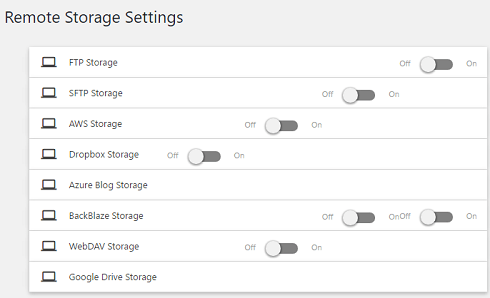XCloner Remote Storage Settings post will guide you and help you to configure and add remote storage to your backups and more.
Last Updated; June 8, 2020
Latest News: Updated the documentation.
The following instructions shows you all the different remote storage allowed in XCloner plugin. Each remote storage requires different settings to be enabled and configured. All remote settings must be verified first before you save the settings. Then simply switch On the remote storage.
Some require an application key or API key. Links have been provided for you to get your keys. Google Drive Storage requires you to install an additional plugin before you can enable remote storage Google Drive.
What you need:
- Xcloner plugin.
XCloner Remote Storage Settings
Step 1 ) The following image Remote Storage Settings allows you to set up any remote storage you might want to implement for your backups.
Remote Storage Options
- FTP Storage
- SFTP Storage
- AWS Storage
- Dropbox Storage
- Azure Blog Storage
- BackBlaze Storage
- WebDAV Storage
- Google Drive Storage

Note: Click on each tab to expand the tab and edit the settings. Make sure you verify the settings before you enable each remote storage option. Also make sure you turn On each remote option you wish to enable.
Step 1-a ) Make sure you verify before you save the settings.

Step 1-b ) Make sure you turn On each remote option you wish to remote too after you have verified and saved the settings.

Step 2 ) The following list each step you need to take to enable each of the following options illustrated above in the image.
FTP Storage
- Ftp Hostname
- Ftp Username
- Ftp Password
- Ftp Storage Folder
- Ftp Transfer Mode = Passive or Active
- Ftp Secure Connection = Disable or Enable
- Ftp Timeout
- Ftp Cleanup (days)
SFTP Storage
- SFTP Hostname
- SFTP Username
- SFTP or Private Key Password
- SFTP Private Key(RSA)
- SFTP Storage Folder
- SFTP Timeout
- SFTP Cleanup (days)
AWS Storage
- AWS Key
- AWS Secret
- AWS Region
- AWS Bucket Name
- AWS Cleanup (days)
Dropbox Storage
- Dropbox Access Token
- Dropbox App Secret
- Dropbox Prefix
- Dropbox Cleanup (days)
Azure Blog Storage
- Azure Account Name
- Azure Api Key
- Azure Container
- Azure Cleanup (days)
BackBlaze Storage
- BackBlaze Account Id
- BackBlaze Application Key
- BackBlaze Bucket Name
- BackBlaze Cleanup (days)
WebDAV Storage
- WebDAV Base Url
- WebDAV Username
- WebDAV Password
- WebDAV Target Folder
- WebDAV Cleanup (days)
Google Drive Storage
This storage option requires the XCloner-Google-Drive WordPress Plugin to be installed and activated.
PHP 5.5 minimum version is required. Click on the following link XCloner Google Drive to download and install the plugin.
Click on the following link Generate WordPress Backups to continue with this tutorial.
If you have any questions please let me know.
Enjoy.
Go Back To XCloner Tutorials List
Hi, I am attempting to set up the FTP storage but am getting an error with the Ftp Storage Folder.
As I am new to using FTP, I don’t understand how it works.
I used a folder on my hard drive, e.g. D:BackupsWordpress Backup
Obviously, this is not correct because it returns an error. “FTP connection error: Root is invalid or does not exist: D:BackupsWordpressBackup/”. Can you please tell me how to select a folder for storage correctly?
Many thanks
Terry Atman
Hi, ftp storage is not designed for the local hard drive in your laptop or desktop. This feature is designed to allow you to choose your own storage place other than the ones already available in the plugin. For example you might manage your own server and decide to use the hard disk in your server to store your backups.
Let me know if the above helps you.
Kind regards